
A well-preserved pair of houses with a breezeway between them and an old-fashioned storefront. The corner store preserves some memories of the time when it sold auto parts.


Comments

A well-preserved pair of houses with a breezeway between them and an old-fashioned storefront. The corner store preserves some memories of the time when it sold auto parts.



Old Pa Pitt recommends wandering in back alleys as a hobby. You never know what you might find, from antique sculpture to ghost signs. Dimling’s hasn’t had a candy shop here for more than fifty years, but this sign still sits on the back of the building the shop once occupied, facing Exchange Way at the intersection with Tito Way.

When it was prospering, Dimling’s Liberty Avenue shop occupied two buildings and covered them with tiles that made the entire Liberty Avenue façade a giant billboard. The picture above is a detail of a much larger photograph taken by the Pittsburgh City Photographer in 1965: it may still be encumbered by copyright (although probably not, unless the copyright was renewed), but if the city of Pittsburgh wants a fee for using it Father Pitt can probably afford a quarter or so.
By the 1970s, the buildings were still a billboard for Dimling’s, but a photo from 1973 shows that the tenants were Arthur Treacher’s, an adult theater, and a massage parlor.
The wheel of history kept turning, however, and the restoration of Liberty Avenue brought these buildings back to respectable use. Peeling away the tiles revealed the old Victorian fronts, which have been lovingly restored and now make up part of the extraordinary Victorian streetscape of Liberty Avenue in the Cultural District.

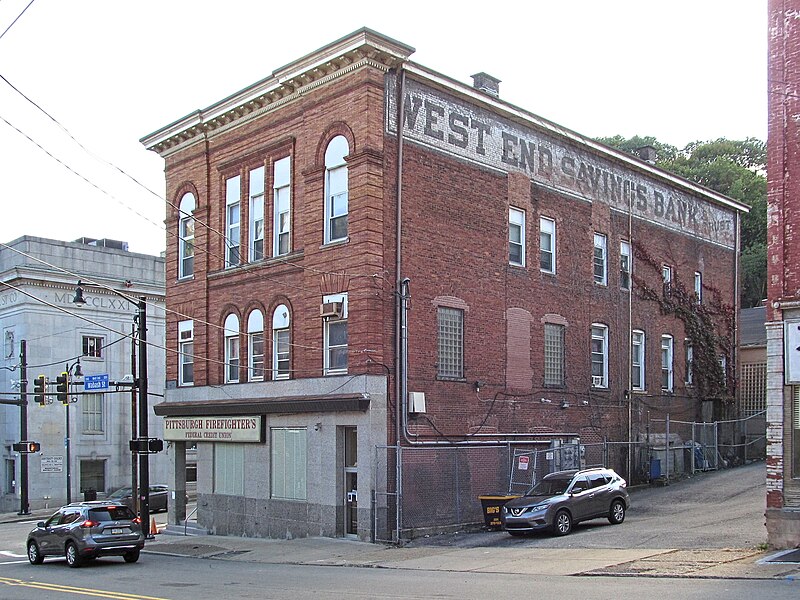
This building probably dates from the 1890s, and it looks from the style as though the well-preserved painted sign may date from the same era.

The building still belongs to a kind of bank and is kept in good shape, though its ground floor was unfortunately modernized back when that seemed like a good idea.
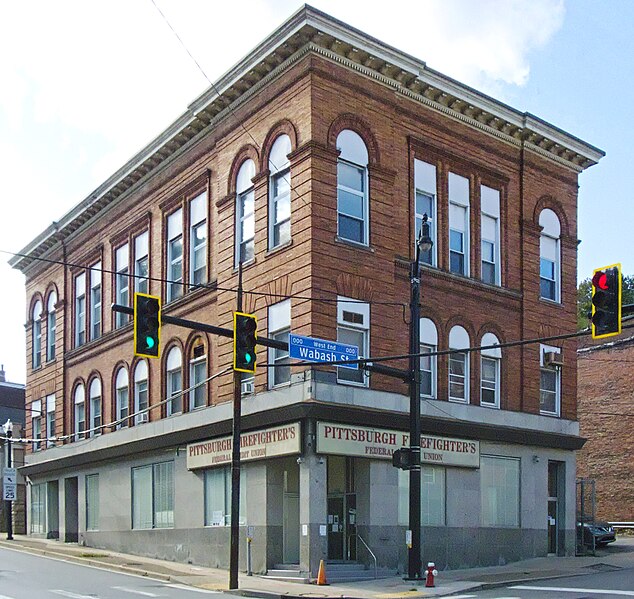

On the back, facing traffic coming down the hill from Noblestown Road, was another sign advertising the West End Savings Bank & Trust Co., but it was later painted over with an advertisement for Heselbarths Real Estate—Insurance.

This curious structure is at the back end of a commercial building on Fifth Avenue, where it faces the alley called Watson Street. It’s hard to tell from the old maps, but this may be the back end of the building that used to be the Uptown postal station, Pittsburgh 19. The tower is curious for multiple reasons: first, that there is a tower here at all along the alley rather than at the front of the building where it could be seen; second, because it looks as though it was put together from two slightly mismatched halves; third, because of the extraordinarily narrow Romanesque windows that look as though someone was expecting an attack by enemy archers. The upper floor, which is what makes this look like a tower, may be a later addition.
If you enlarge the picture, you will notice a ghost sign on the building next door: Progressive People Want Perfect Liquors. The position of this sign—where it is all but invisible unless you are looking down on it from a distance with a long lens—suggests that it may be even older than the tower that obscures it.
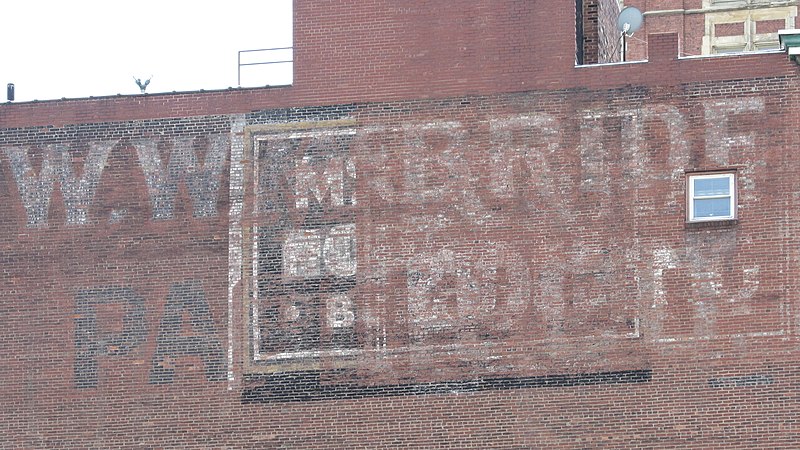
The seven-storey building at the corner of Ross Street and Third Avenue was the home of the W. W. McBride Paper Company. Multiple layers of painted signs make it hard to read any one of them, but the name “W. W. McBride” is clear enough.
The Century Cyclopedia of History and Biography of Pennsylvania (1904) has an extensive biography of William Wilson McBride, and we quote the part that has to do with the firm and the building:
In 1890 Mr. McBride bought a half interest in the well-established paper business of Morrison, Cass & Company, of Pittsburg, which owned large paper mills at Tyrone, Pennsylvania. The other half interest was retained by John Cooper, of Pittsburgh, who had been a member of the original firm, and the business was carried on under the name of Cooper & McBride. After four years Mr. McBride bought out his partner and became the sole proprietor, operating under the title of W. W. McBride & Company. In June, 1902, the business was incorporated as the W. W. McBride Paper Company. During 1901 he built a fine seven-story brick building at the corner of Ross Street and Third Avenue, containing the offices, sales department, and storage rooms.
By 1923, according to the Pittsburgh Historic Maps site, the McBride Building had become the Bowman Building, so these signs must all date from before that time.
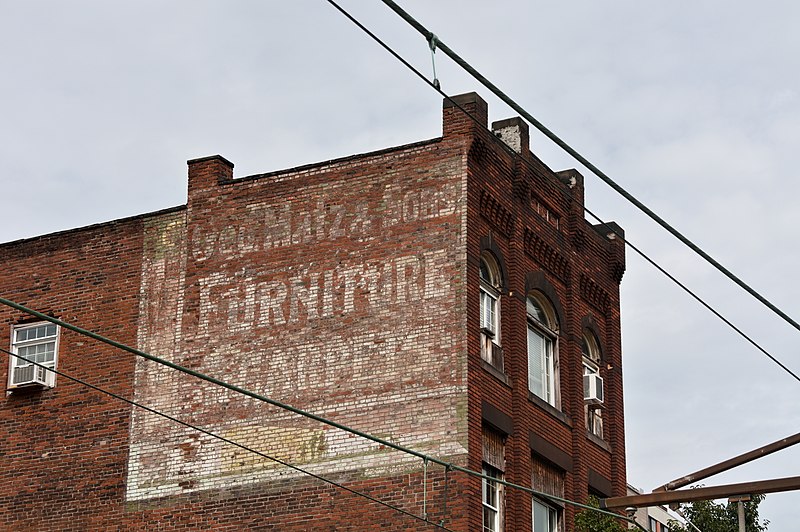
Until fairly recently, almost all the businesses along Warrington Avenue in Allentown bore German names. This building still bears a ghost sign for Geo. Matz & Sons Furniture and Carpets. The style of the building is typical German Commercial Romanesque, of the sort that is very common in the old German neighborhoods in Pittsburgh. The storefront has been filled in with Perma-Stone, one of the Four Horsemen of the Apocalypse, and the windows have been replaced with smaller standard-sized windows (with fake “multi-pane” slats, because window companies insist on adding those even though they look completely wrong on most buildings from the middle nineteenth century onwards). But both those things could be undone when Allentown becomes trendy enough to make restoration worthwhile, and otherwise the façade of the building is very well preserved.

When he published his recent pictures of the Craig Street automotive row, old Pa Pitt promised his readers pictures of some of the other nearby buildings from the early days of the automobile. Yesterday he walked over to Melwood Avenue to get pictures of the old Chevrolet dealer and found that he hadn’t walked fast enough, because this is what it looks like now:
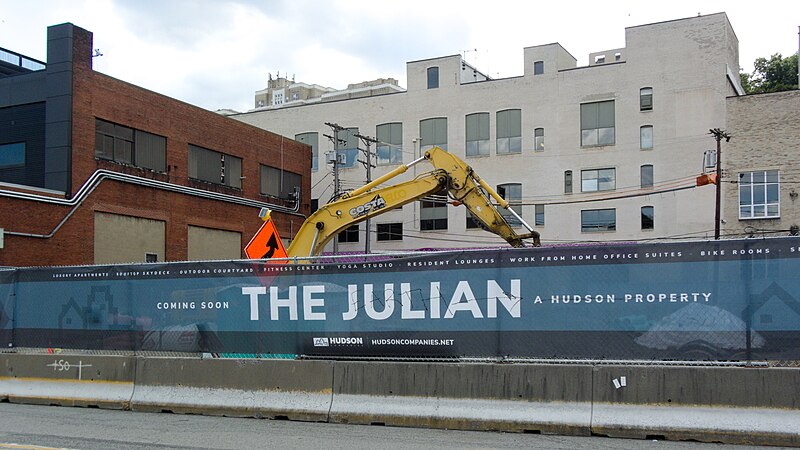
Yes, it has been demolished for another apartment tower. Doubtless this will bring rolling waves of prosperity, though not everyone in the neighborhood is happy about it:

On the bright side, the demolition revealed an old painted sign that probably had not been visible for more than a hundred years:

Father Pitt has not been able to read the names of the two superimposed companies. This wall had been obscured by the Chevrolet dealer since before 1923, so this sign dates from the first decades of the automobile.
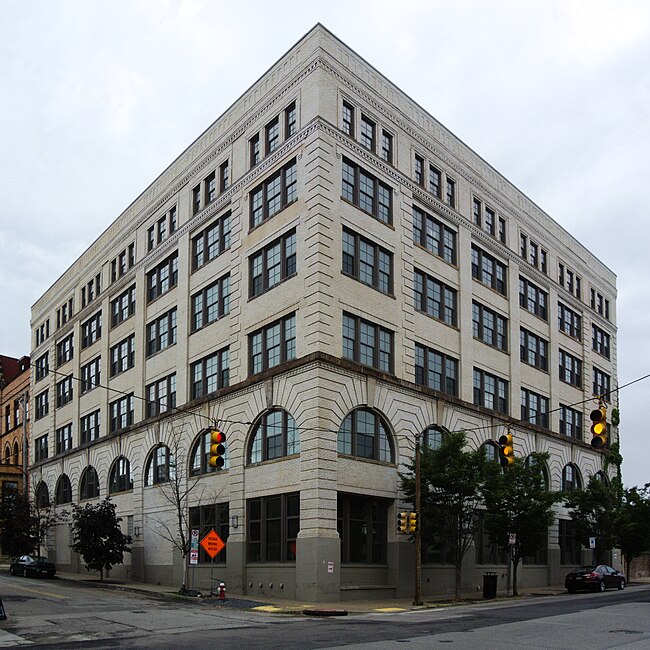
The T. R. Mackey Baking Co. became the home of the Famous Biscuit Company in 1911, and you can still see the Famous Biscuit sign on the eastern wall of the building. The style bridges the gap between Romanesque and classical. After a long period of deterioration, the building has been beautifully restored as loft apartments.
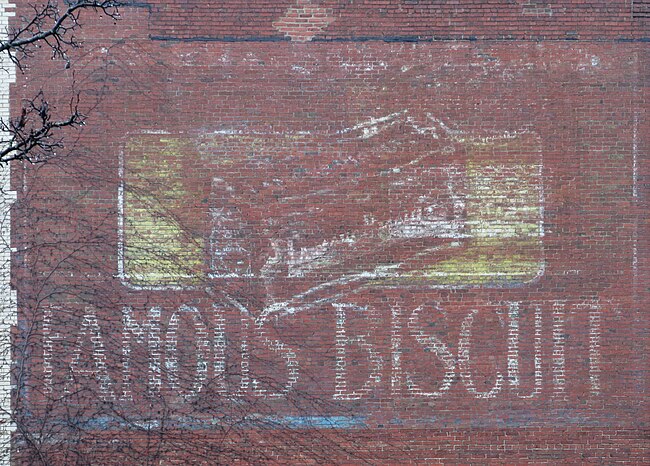
Would you like to know the whole exciting story of the founding of the Famous Biscuit Company? You can read it in the biography of founder John Archibald Simeral in the massive History of Pittsburgh and Environs published in 1922. “Among its well known brands are the ‘Dlekta,’ ‘Orienta,’ and ‘Bon Ton,’ and the slogan used by the company in its widespread advertising campaigns is ‘One Hundred and Fifty Good Things to Eat.’ ”
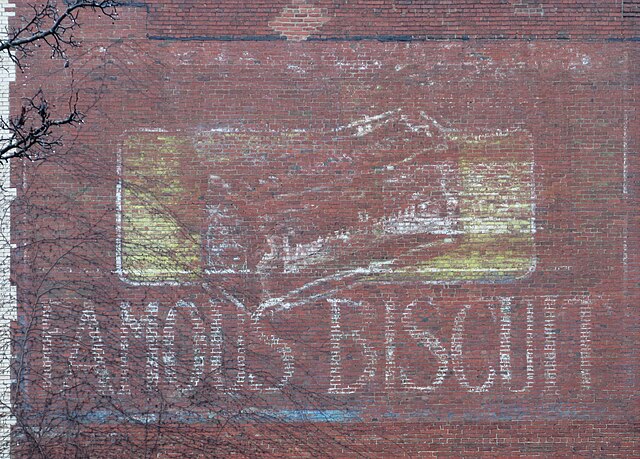
Ghost signs preserve history otherwise forgotten. Who remembers the Famous Biscuit company? In this case, the sign also preserves another bit of history that might escape the casual observer. It faces east on Forbes Avenue, thus serving as a memorial of a time when Forbes Avenue Uptown was a two-way street.